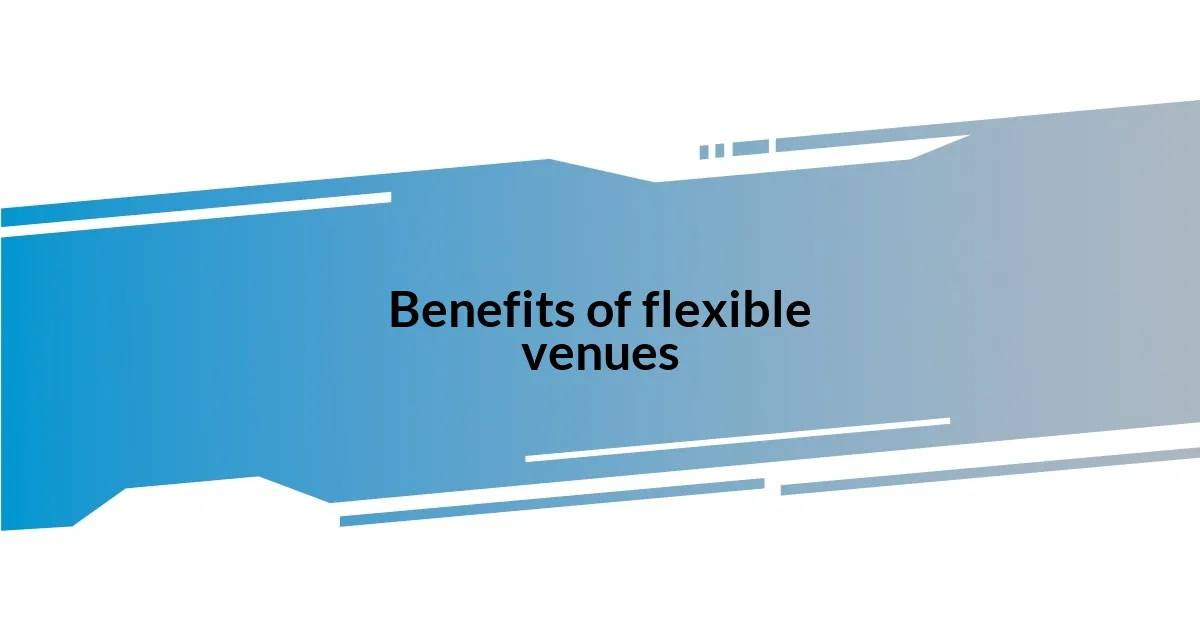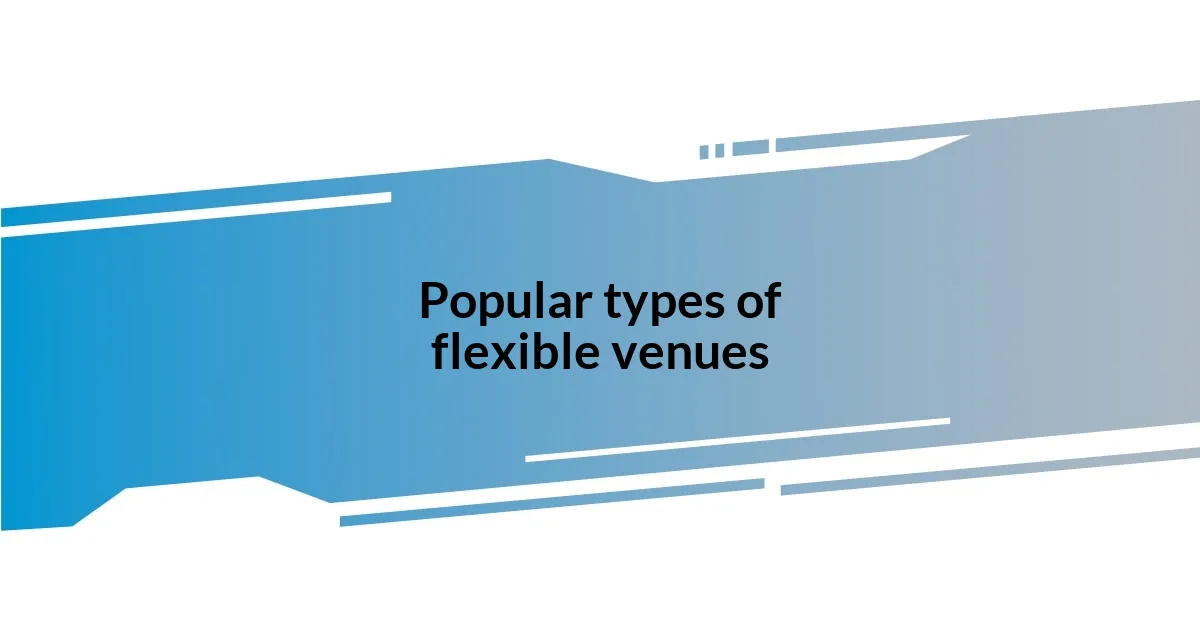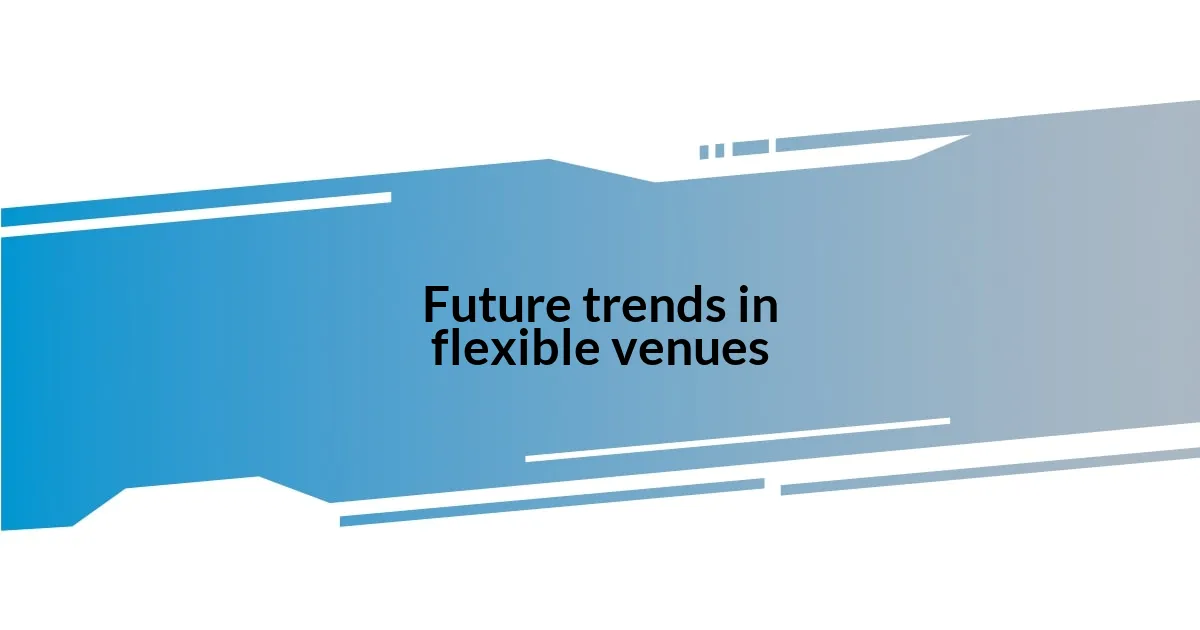Key takeaways:
- Flexible venues enhance attendee experiences by adapting to various needs and layouts, fostering creativity and collaboration.
- Key benefits include adaptability for different group sizes, cost-effectiveness by reducing extra rentals, and increased attendee satisfaction through versatile setups.
- Essential features of flexible venues include modular furniture, technology integration, natural light, and good acoustics, which all contribute to a positive atmosphere.
- Future trends highlight the integration of technology and sustainability, along with a rise in community-centric spaces that foster inclusivity and support local cultures.

Understanding flexible venues
Flexible venues are more than just spaces; they are transformative environments tailored to suit various needs. I once attended an event at a venue that effortlessly shifted from a tech conference to a lively networking space, and it got me thinking: how often do we overlook the adaptability of our event spaces? This flexibility not only enhances the attendee experience but also maximizes the potential of any gathering.
I remember planning a community fundraiser in a venue that could easily be reconfigured for different activities. One moment, it was set up for a silent auction, and just an hour later, it was transformed into a vibrant space for live performances. Have you ever been in a place that surprised you with its versatility? That sense of discovery can create lasting memories and encourage deeper connections among participants.
The real magic of flexible venues lies in their ability to foster creativity and collaboration. When space adapts to the way people work and gather, it encourages spontaneous interactions and innovative ideas. I love watching how a room’s layout can shift the energy—whether it’s a circle of chairs for intimate discussion or wide rows for keynote speakers. Isn’t it incredible how the right environment can inspire new perspectives?

Benefits of flexible venues
Flexible venues offer a unique advantage: they can adapt to diverse group sizes and formats without hassle. I recall organizing a workshop where we expected a cozy group of ten, but in the end, twenty people showed up. The venue’s flexible layout allowed us to quickly rearrange the space, ensuring everyone felt included and engaged. Isn’t it reassuring to know that a venue can seamlessly accommodate last-minute changes?
Another significant benefit is cost-effectiveness. I’ve often noticed that selecting a flexible venue minimizes the need for additional rentals for different setups, saving both time and money. For instance, during a corporate retreat, we utilized one space for breakout sessions, meals, and presentations. The venue’s ability to transform throughout the day kept our budget in check while fostering a cohesive experience for all attendees. Isn’t it nice to feel you are maximizing resources while delivering a superior experience?
Lastly, flexible venues can enhance attendee satisfaction by ensuring comfort and versatility. I remember attending a creative brainstorming session where the space was shifted to allow for both cozy table discussions and open areas for collaborative art projects. This duality not only kept the energy high but also catered to different personalities. Who doesn’t appreciate a venue that speaks to their needs?
| Benefit | Personal Insight |
|---|---|
| Adaptability | Seamlessly adjusting layouts caters to changing group sizes. |
| Cost-Effectiveness | Reduces extra rentals, ensuring budget-friendly choices. |
| Increased Satisfaction | Enhances comfort by catering to diverse needs within a single space. |

Key features to consider
When considering flexible venues, a few features stand out to me as essential. First, the adaptability of the space itself is crucial. At a recent networking event, I was impressed by a venue that not only accommodated varying setups but also seamlessly integrated technology for presentations. It reminded me how important it is for venues to support different styles of interaction. Here are some key features to keep in mind:
- Modular Furniture: Easily rearrangeable pieces like moveable tables and chairs enhance flexibility.
- Tech Integration: Access to AV equipment and reliable Wi-Fi is a must for modern gatherings.
- Natural Light: Spaces with plentiful windows create an inviting atmosphere and can positively impact mood.
Additionally, the ambiance plays a significant role in the venue’s effectiveness. I vividly recall a workshop held in a bright, airy venue that used colors and textures to stimulate creativity. The right ambiance not only fosters focus but also encourages engagement. Think about these aspects when choosing a space, as they can drastically impact the overall experience.
- Acoustics: Sound design is key for presentations and discussions, ensuring everyone can hear and be heard.
- Accessibility: Facilities should be convenient for all participants, supporting inclusivity.
- Breakout Spaces: Having smaller areas for intimate conversations can create deeper connections.

Popular types of flexible venues
When it comes to popular types of flexible venues, community centers often come to mind. I remember attending a local fair held at one such venue. What struck me was how effortlessly the space was transformed from a bustling marketplace to an inviting area for performances. These centers can host various events, making them a staple in any community. Isn’t it wonderful to see a single venue radiate versatility?
Another intriguing type is co-working spaces, which have surged in popularity. I once worked on a project at a co-working venue designed for collaboration, equipped with comfy lounges and open meeting areas. The atmosphere encouraged spontaneous brainstorming sessions, and I realized how conducive these spaces can be for creativity. Isn’t it amazing how the right environment can spark collaboration?
Don’t overlook outdoor venues, either. I have fond memories of a summer company picnic at a park with an adaptable tent setup. We enjoyed the sun during lunch and moved under the tent for games when it got too hot. The flexibility of nature combined with a well-planned layout ensures that we can embrace the best of both worlds, doesn’t it? Outdoor venues truly encapsulate the essence of versatility in a way that indoor spots sometimes struggle to match.

Future trends in flexible venues
The future of flexible venues is poised to embrace even more technological advancements. I recently visited a venue that was experimenting with augmented reality, which allowed attendees to engage with the space in entirely new ways. Imagine walking into a room where the walls could transform based on the theme of your event—how exciting would that be? It’s clear that merging tech with physical space will redefine how we experience gatherings.
Sustainability is also becoming a significant trend in the evolution of flexible venues. I recall attending a conference in a facility that showcased eco-friendly materials and energy-efficient systems. It felt great to support a space that values both function and the environment. As more venues prioritize green practices, we can expect a surge in interest from organizations looking to align their events with sustainability goals. Doesn’t it feel good to know that our choices can impact the planet positively?
Lastly, the concept of community-centric spaces is emerging as a powerful trend. A few months back, I saw a small community venue host a series of events that empowered local artists and entrepreneurs. They transformed the venue into a vibrant hub for networking and creativity. This movement towards inclusivity not only creates a more welcoming atmosphere but fosters a sense of belonging. Isn’t it amazing how flexible venues can cultivate connections and support local cultures?